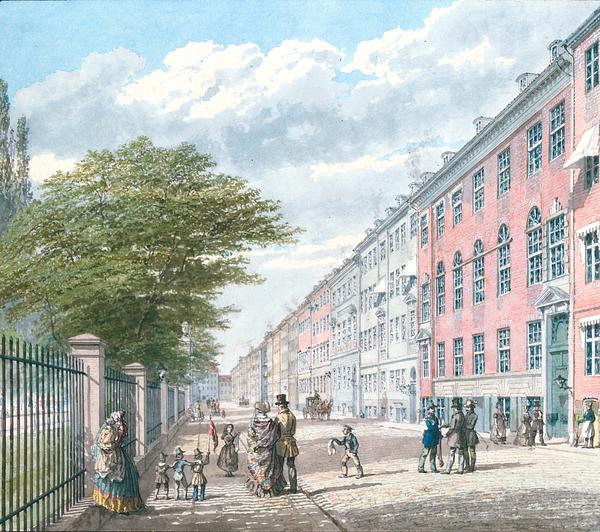The painter H.G.F. Holm found his subject matter throughout the inner city of Copenhagen. However, certain neighbourhoods appear to have caught his interest – especially those where affluent audiences lived, for example Frederiksstaden.
[1] While perambulating this neighbourhood, he also made his way to Kronprinsessegade, a street which runs along The King’s Garden between Gothersgade and Sølvgade. He depicted several scenes from this street.
In the 1840s, Kronprinsessegade was one of the most prestigious streets in the so-called Adel- and Borgergade district, a fact which is also evident from Holm’s watercolour. The people seen strolling along the then-cobbled street lined by tall, stately properties are well-to-do citizens wearing elegant clothes and tall hats. All is well with the world on this bright, sunny summer day. Among the most conspicuous figures we find a uniformed soldier and three small children, one of whom is holding a Dannebrog flag. Together, they bear witness to the general atmosphere described as the ‘spirit of 1848’, a patriotic awakening among the Danes.
[2]Kronprinsessegade was laid out on a strip of land taken from the Rosenborg Castle Garden (now known as The King’s Garden) in the late eighteenth century. The new construction was prompted by the urgent need for new housing for some of the many people who had become homeless after the great fire in Copenhagen in 1795. A plan for the street, which was named after the then Crown Princess Marie Sophie Frederikke (1767–1852), as well as for the buildings in the street was drawn up by city architect Peter Meyn (1749–1808) and city surveyor J.H. Rawert (1751–1823). In all likelihood it was Rawert who did the masterplan for a large number of properties in the street, including Kronprinsessegade 30, which was built in 1806–1807 in the neoclassical style.
Holm’s watercolour is directly linked to the history of The David Collection, as the collection’s founder, C.L. David, bought Kronprinsessegade 30 in 1917, where his great-grandfather, Joseph Nathan David (1758-1830) had lived from 1810-1830. In 1847 the property was modernised under the supervision of L.A. Winstrup (1815–1889), but in 1951 it was restored to its original appearance by architect Kaare Klint (1888–1954). All the houses in Kronprinsessegade were listed in 1945.
